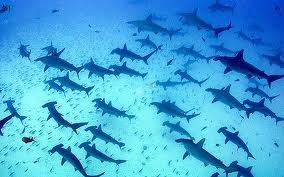

Yep...Hammerheads! |
"The best on the planet for pelagic life" Lose yourself in the Legendary Galapagos Islands! |
OVERVIEW of the GALAPAGOS
|
The marine life in the Galapagos is some of the most spectacular pelagic diving on the planet! It is one of the rare places where you pass through a bank of hundreds of hammerheads while chasing a 60 foot whale shark. Toss in Galapagos sharks, silky sharks, sea turtles, giant free swimming morays, schools of thousands of pelagic fish species like barracuda or jacks along with large schools of tropicals like king angelfish and you have just 1 dive at Darwin. At Wolf, you can expect huge Galapagos sharks, more hammerheads, eagle rays within feet-sometimes inches and Cabo Marshall will put you face to face with giant manta rays and inside a school of millions of black-striped salemas. Macro life is spectacular at Cousins where the abundant (green) black coral shelters seahorses, blennies, nudibranches, hawkfish and frogfish. And this is but a mere taste of why divers consistently proclaim the Galapagos to have the most healthy marine life in the Pacific as well as the best place to dive for pelagic life. Exposure Protection: We recommend a 7mm wetsuit, hood and gloves (for protection, not warmth). Water temps are warmer at Darwin than other dive sites, however, dives at Darwin often involve as much as 25 minutes of stationary time which can cause you to feel cooler than when you are in motion. You descend through current, grab hold of rocks on the platform and watch the show as it passes by except when chasing whale sharks. The rocks you grab often have barnacles which will cut your hands if you’re not wearing gloves. So you do need gloves, but for protection, not warmth. Clothing: In spite of being on the equator, it is not as warm as most expect. Darwin called it the coldest place on the equator. We assume he meant at sea level. And after multiple dives or cold thermoclines, you'll feel chilled. We recommend light weight, long pants and long sleeve shirts. Shorts can be worn, but bear in mind, the one thing people always seem to say is that they wish they had brought some warmer clothing. Do bring a fleece, jacket or sweatshirt to use after dives. Shorts/athletic pants and a light sweatshirt are perfect for the evenings. Sports sandals or sneakers are fine for your land visit. Crocs, neoprene shoes or even slippers are appropriate onboard. Electricity Passport and/or Visa Requirements Water Quality & Health Risks Language & Currency The US dollar is the basic unit of currency. There are ATMs on San Cristobal and Santa Cruz as well as the Guayaquil and Quito airports. Travelers checks are not so easy to cash, therefore we do not recommend them. Time |
Location and Size The Galápagos Archipelago consists of 3,040 sq. miles of land spread over 17,000 sq. miles of ocean. The largest of the islands is Isabela and makes up close to three-quarters of the total land area of the Galápagos. The group consists of 18 main islands, 3 smaller islands, and 107 rocks and islets. The first islands formed here at least 8 million and possibly up to 90 million years ago. While the older islands have disappeared below the sea as they moved away from the mantle plume, the youngest islands, Isabela and Fernandina, are still being formed, with the most recent volcanic eruption in April 2009 where lava from the volcanic island Fernandina started flowing both towards the island's shoreline and into the centre caldera. Weather Sea Conditions Each month brings unique climate variations and wildlife viewing opportunities. Peak season for naturalist tours is typically December through May when the seas are the calmest and the weather the warmest. However, the summer months June, July and August are also very popular as the animals are more active. September through November is typically low season when most boats will leave the islands for dry dock. For divers peak season is from July - November when whale sharks can be found at Wolf & Darwin. Demographics 2010 estimates place the population around 25,000 people. Five of the islands are inhabited: Baltra, Floreana, Isabela, San Cristobal and Santa Cruz. |





